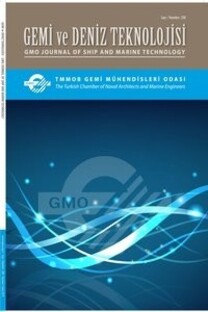Eklemeli İmalat Yöntemiyle Tekne İnşaatında Dolgu Yoğunluğu ve Örüntüsünün Mukavemet Üzerindeki Bileşik Etkisi
Tekne üretiminde eklemeli imalat yöntemi, Polilaktik asit (PLA), Yazım örüntüsü, Dolgu yoğunluğu
The Effects of Infill Density and Pattern on the Strength of Marine Small Craft Building by Additive Manufacturing Method
Additive manufacturing method in marine small craft building, Polylactic acide (PLA), Printing infill pattern, Printing infill density,
___
- Aloyaydi, B., Sivasankaran, S., Mustafa, A. (2020). Investigation of infill-patterns on mechanical response of 3D printed polylactic-acid. Polymer Testing, 87. https://doi.org/10.1016/j.polymertesting.2020.106557
- American Society for Testing and Materials, (2016), Standard Practice for Preparation of Metallographic Specimens, ASTM International, 82(C), 1–15., doi: 10.1520/D0638-14.1.
- Bekker, M., Verlinden, C., Galimberti, G. (2017). Challenges In Assessıng The Sustaınabılıty Of Wıre + Arc Addıtıve Manufacturıng For Large Structures., Solid Freeform Fabrication Symposium,
- Colorado, H. A., Velásquez, G., Monteiro, N. (2020). Sustainability of additive manufacturing: the circular economy of materials and environmental perspectives. Journal of Materials Research and Technology, 9(4), 8221–8234. https://doi.org/10.1016/j.jmrt.2020.04.062
- Delgado, D., Clayton, P., O’Brien, W. , Seepersad, C., Juenger, M., Ferron, R., Salamone, S. (2018). Applications of additive manufacturing in the construction industry – A forward-looking review. Automation in Construction, 89, 110–119. https://doi.org/10.1016/j.autcon.2017.12.031
- Garmulewicz, A., Holweg, M., Veldhuis, H., Yang, A. (2018). Disruptive Technology as an Enabler of the Circular Economy: What Potential Does 3D Printing Hold? California Management Review, 60(3), 112–132. https://doi.org/10.1177/0008125617752695
- Güngör, A., (2020). Türkiye’de Katmanlı İmalat ve Gemi İnşaatı Üzerine Etkileri, Gemi ve Deniz Teknolojisi Dergisi, 218, 36 – 53.
- Heras, D., Genedy, M., Reda Taha, M. M. (2020). Examining the significance of infill printing pattern on the anisotropy of 3D printed concrete. Construction and Building Materials, 262. https://doi.org/10.1016/j.conbuildmat.2020.120559
- Kariz, M., Sernek, M., Obućina, M., Kuzman, K. (2018). Effect of wood content in FDM filament on properties of 3D printed parts. Materials Today Communications, 14, 135–140. https://doi.org/10.1016/j.mtcomm.2017.12.016
- Khoo, X., Teoh, J., Liu, Y., Chua, C., Yang, S., An, J., Leong, K., Yeong, Y. (2015). 3D printing of smart materials: A review on recent progresses in 4D printing. Virtual and Physical Prototyping, 10(3), 103–122. https://doi.org/10.1080/17452759.2015.1097054
- Kumar, R., Kumar, M., Chohan, S. (2021). The role of additive manufacturing for biomedical applications: A critical review. In Journal of Manufacturing Processes, 64, 828–850. https://doi.org/10.1016/j.jmapro.2021.02.022
- Duigou, A., Correa, D., Ueda, M., Matsuzaki, R.,Castro, M. (2020). A review of 3D and 4D printing of natural fibre biocomposites. In Materials and Design, 194, https://doi.org/10.1016/j.matdes.2020.108911
- Lubombo, C., Huneault, A. (2018). Effect of infill patterns on the mechanical performance of lightweight 3D-printed cellular PLA parts. Materials Today Communications, 17, 214–228. https://doi.org/10.1016/j.mtcomm.2018.09.017
- Ma, Q., Rejab, M. R. M., Kumar, A. P., Fu, H., Kumar, N. M., Tang, J. (2021). Effect of infill pattern, density and material type of 3D printed cubic structure under quasi-static loading. Proceedings of the Institution of Mechanical Engineers, Part C: Journal of Mechanical Engineering Science, 235(19), 4254–4272. https://doi.org/10.1177/0954406220971667
- Mohamed, A., Masood, H., Bhowmik, L. (2015). Optimization of fused deposition modeling process parameters: a review of current research and future prospects. Advances in Manufacturing, 3(1), 42–53. https://doi.org/10.1007/s40436-014-0097-7
- Momeni, M., Mehdi, N., Liu, X., Ni, J. (2017). A review of 4D printing. Materials and Design, 122, 42–79. https://doi.org/10.1016/j.matdes.2017.02.068
- Şükrü, O., T., Şener, B. (2019). The Use of Additive Manufacturing in Maritime Industry. International Journal of Engineering Trends and Technology, 67(6). http://doi.org/ 10.14445/22315381/IJETT-V67I6P209
- Pandzic, A., Hodzic, D., Milovanovic, A. (2019). Effect of infill type and density on tensile properties of pla material for fdm process., Proceedings of the International DAAAM Symposium, 30(1), 545–554. https://doi.org/10.2507/30th.daaam.proceedings.074
- Sharma, K., Srinivas, G. (2020). Flying smart: Smart materials used in aviation industry. Materials Today: Proceedings, 27, 244–250. https://doi.org/10.1016/j.matpr.2019.10.115
- Shie, M. Y., Shen, Y. F., Astuti, S. D., Lee, A. K. X., Lin, S. H., Dwijaksara, N. L. B., Chen, Y. W. (2019). Review of polymeric materials in 4D printing biomedical applications. In Polymers., 11(11). https://doi.org/10.3390/polym11111864
- Srinivasan, R., Nirmal Kumar, K., Jenish Ibrahim, A., Anandu, K., Gurudhevan, R. (2020). Impact of fused deposition process parameter (infill pattern) on the strength of PETG part. Materials Today: Proceedings, 27, 1801–1805. https://doi.org/10.1016/j.matpr.2020.03.777
- Strickland, J., Strickland, D. (2016). Applications of Additive Manufacturing in the Marine Industry. Practical Design of Ships and Offshore Structures, https://doi.org/10.13140/RG.2.2.29930.31685
- Wang, B., Zhang, Z., Pei, Z., Qiu, J., Wang, S. (2020). Current progress on the 3D printing of thermosets. Advanced Composite Hybrid Materials, 3, 462–472 https://doi.org/10.1007/s42114-020-00183-z
- Wohlers, T., Gornet, T. (2016). History of Additive Manufacturing, Wohlers Report, 2-28.
- Zhou, Y., Huang, W. M., Kang, S. F., Wu, X. L., Lu, H. B., Fu, J., Cui, H. (2015). From 3D to 4D printing: approaches and typical applications. Journal of Mechanical Science and Technology, 29(10), 4281–4288. https://doi.org/10.1007/s12206-015-0925-0
- https://composites.umaine.edu/3dirigo-the-worlds-largest-3d-printed-boat/ [Online] [Erişim 10.05.2022]
- https://www.polimi.it/en/articles/mambo-the-worlds-first-3d-printed-fiberglass-boat/ [Online] [Erişim 10.05.2022]
- https://www.ramlab.com/updates/ramlab-unveils-worlds-first-class-approved-3d-printed-ships-propeller/ [Online] [Erişim 10.05.2022]
- ISSN: 1300-1973
- Yayın Aralığı: 2
- Başlangıç: 1955
- Yayıncı: TMMOB Gemi Mühendisleri Odası
Bodrum Yat İnşa Sektörünün GZFT/PESTLE Analizi
Bülent İbrahim TURAN, Mehmet AKMAN, Fuat TURAN
Eklemeli İmalat Teknikleri ve Gemi İnşaatı Endüstrisindeki Potansiyeli
Ali ALICIOĞLU, M. Erden YILDIZDAG
Denizaltılarda Stirling Motor Temelli Havadan Bağımsız Tahrik Sistemlerinin (AIP) Değerlendirilmesi
Kadir Beytulllah GÜNDÜZ, Yasemin ARIKAN ÖZDEN
Dönebilir İticinin Sert Hava Koşullarında Bir Balıkçı Gemisinin Manevra Kabiliyetine Etkisi
Kadir SARIÖZ, Ömer GÖREN, Ömer Kemal KINACI, Aydin SULUS
Dikili Açıklarında Bir Açık Deniz Rüzgâr Çiftliğinin Kavramsal Tasarımı
Açık Kaynaklı Panel Yöntemi Kodlarının Ticari Kod ile Karşılaştırılması ve Değerlendirilmesi
Muhammed UÇAR, Emre UZUNOĞLU, Elif OĞUZ
Otonom Su Üstü Araçları için COLREG Kurallarını İçeren Çarpışma Önleyici Sistem
